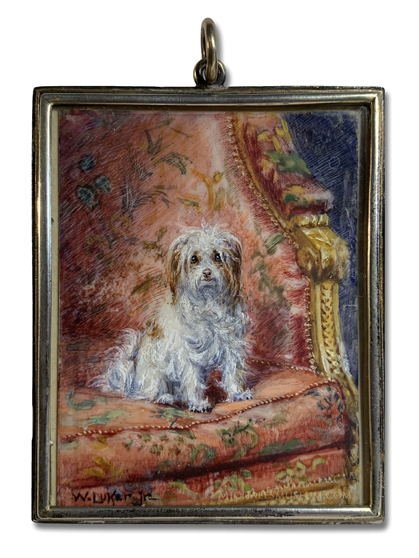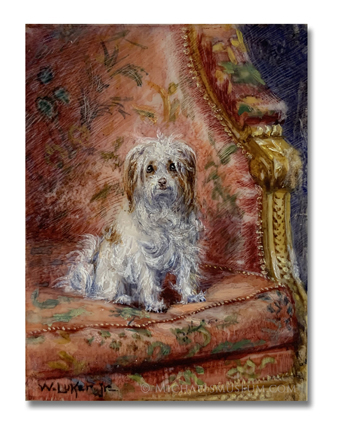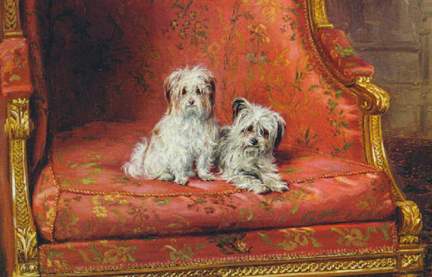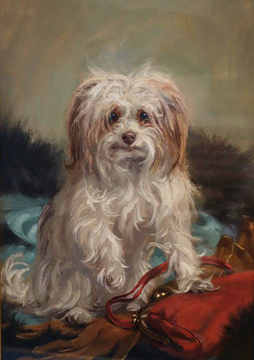| |
English Artist: William Luker, Jr.


White and Tan Terrier,
Sitting on a Louis XVI Armchair
English
circa 1910-1914
by William Luker, Jr. (1867-1951)
[signed obverse, lower left ,"W. Luker, Jr."]
1 3/4 x 2 3/8 inches (sight)
watercolor on ivory; housed in a closeable, sterling silver locket frame (hallmarked 1914)
(Although the locket frame is hallmarked 1914, it is believed the portrait dates closer to 1910, as similar paintings by Luker of the same subject are dated 1910.)


A view of the portrait outside its case, allowing its colors and
brush strokes to be seen more clearly without the distortion or
reflection that is often caused by the glass lens of a miniature's case
(Click + symbol above for an enlarged view)
Luker painted at least two other portraits of the same dog (presumably, the beloved pet of a wealthy patron). The first image below, titled "Companions", is a larger oil on canvas (16 x 24 inches) that was sold at auction by Christie's in 1998 for £9,200. The second image below, titled "Le Petit Chien", dated 1910 and also an oil on canvas (12 x 18 inches), was offered at auction in Monte Carlo in 2016, but remained unsold. The current owners or whereabouts of either portrait are unknown.


About the Artist: The eldest of the six surviving children (six others died in early childhood) of William Luker, Sr. (1828-1905) and Ada Augusta Margetts (1839-1930), William Luker, Jr. was born in London, in 1867. He is identified alternatively in some records as William Luker, Jr., and in others as William Luker II. He was known more commonly to his family and friends as "Willie". His father was an accomplished landscape painter, particularly known for his pastoral scenes of horses, cows, sheep and Scottish highland cattle; and he imparted his knowledge of painting to his son, William, whom he saw as possessing natural artistic genius. Changing tastes of the late Victorian era brought difficult times to the Luker family, however. As the public's appetite for serene pastoral paintings gradually waned in favor of more lively modern works, the elder William fell on financial difficulties and slipped into a long period of depression. A later published account of this period outlines in unfavorable terms the family dysfunction that ensued: a father distant and unengaged, a mother overly indulgent to her sons, idle sons who pursued immoral vices at the expense of self betterment, and daughters denied higher education for lack of money. Louisa Harriet Luker, a younger sister of William Luker, Jr., described the family of this period as "broken down" and "degenerate" and colorfully described a scene in which her mother fell screaming to the floor upon learning that her beloved "Willie" had gotten a family servant pregnant and then secretly married her. Records of the period do reveal that, in 1888, at the age of 21, William, Jr. did indeed marry domestic servant Margaret Stadowicka, a Polish immigrant eight years his senior. Perhaps prompted by the eventual onset of maturity or, more likely, motivated by the need to provide for his own family, the young artist eventually refocused his energy on painting. He painted numerous portraits and London city scenes, but he experienced his greatest success painting animals, albeit in a different manner than his father had. That is to say, rather than painting quiet (some would say solemn) pastoral scenes, he painted animals that were the object of other's affections (people's pets, champion show dogs, racehorses, and the like), and he depicted them with personality and charm. Worthy of particular mention, in about the year 1897, he painted Florizel II, a prized bay racehorse of Edward, Prince of Wales (eldest son of Queen Victoria, and himself the eventual King Edward VII). Luker's preferred medium was oil on canvas, but he also painted in watercolor on ivory and executed many fine pen and ink drawings (many of which were used as illustrations in books and magazines of the period). He exhibited extensively at the Royal Society of British Artists (of which he was also a member) from 1895 to 1945; and he exhibited at the Royal Academy of Arts from 1915 to 1919. He is known to have works in collections of Her Majesty Queen Elizabeth II (the Royal Collection Trust), The Metropolitan Museum of Art (New York), the University of California Libraries, and the Auckland Art Gallery Toi o Tamaki. Listed by Benezit.
|
|